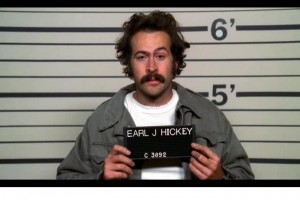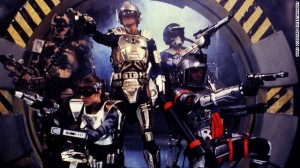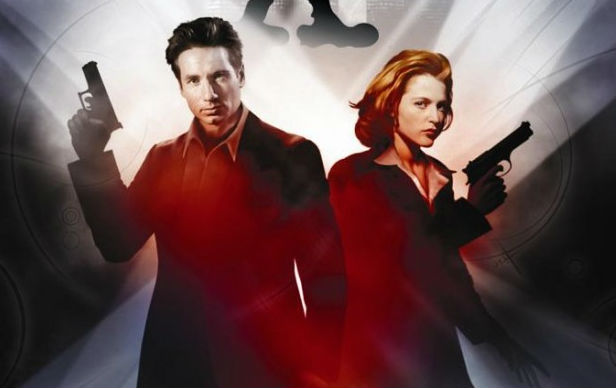Last week, IDW released a new X-Files comic, “X-Files Season 10.” Like the Buffy series from Dark Horse, as well as continuations of Jericho, Smallville, Charmed and Farscape, comics are increasingly becoming home to cancelled television shows. Most of these shows have a cult following, so continued runs in comic form suits them well. I asked the comics team at Sound on Sight to think about what cancelled TV shows they would most like to see completed via comics. Here’s what we came up with…
When the cancellation of Daniel Knauf’s Carnivale was announced, I can’t say that I was completely surprised. I can tell you though; I was pissed! HBO’s Carnivale was one of the most bizarre, subtext-filled supernatural dramas ever on television. Twin Peaks was and is my favorite television series of all time. That series ended after two seasons (like Carnivale). It wouldn’t be until Carnivale aired in 2003 that I would once again discover the surrealist edge that had been lost on TV since Peaks was cancelled in 1991.
Set in in the mid-1930’s depression era dust bowl, Carnivale followed a troupe of travelling carnies as they toured their circus and sideshows across the arid wasteland. In many ways Carnivale felt like an extension of Todd Bowning’s incredible film, Freaks. The setting is perfect for the comic-panel. The characters are even more perfect. Michael J. Anderson’s (known ironically from his role in Twin Peaks) Samson, a dwarf carnival manager is the anchor of the story. His band of circus folk, including a family of burlesque dancers, a blind mentalist and various freaks, have such varied and endlessly interesting conflicts throughout. With undertones of good and evil, alpha and omega, and subplots involving the Knight’s Templar and Christian theology, Carnivale cultivated its own rich mythology.
Ronald D. Moore (Battlestar Galactica creator) was hired to run the first season, but once he left to do Galactica, show creator Knauf took over and ratings sadly fell. After two seasons, Carnivale ended with tons of plot holes left unresolved. A season three comic could fill these holes, but more importantly, would allow Carnivale’s amazing characters a chance to keep travelling their show around the West. Sure, the mythos in Carnivale was great, but what really got me excited about the series were these endlessly fascinating characters. What’s not to love about a show that’s part PT Barnum, part Twin Peaks?
 Terminator: The Sarah Connor Chronicles
Terminator: The Sarah Connor Chronicles
By Sean Tonelli
There has only been one time that I have hated Joss Whedon, and that was when Fox decided to renew that awful Dollhouse show over a third season of the woefully under watched Terminator: The Sarah Connor Chronicles. To make matters worse, Dollhouse ended up being cancelled anyway! Talk about twisting that knife in your back.
When T:SC first aired, it was met with rave reviews and some decent ratings. However due to the writer’s strike, the first season was cut short and by the time the second season rolled around, the marketing train that Fox had rolling had all but subsided. Yet those that stuck around for the second season were rewarded with a deep, sci-fi drama that was filled with heart and originality.
The reason T:SC worked so well was the because of the cast. Mainly, Lena Heady as Sarah Connor, and Summer Glau as Cameron the terminator sent back in time to protect John Connor. While both may have portrayed two different characters, it was because of their nuanced and layered performances that T:SC excelled above typical television affair. Not to mention the fact that this show made Brian Austin Green cool. That’s worth at least 5 seasons right ?!
So why should T:SC live on in comic book form? Aside from the great characters, excellent premise and built in fan-base, there is still the matter of the giant cliff-hanger the show ended on. I don’t mean a whole ‘who shot Mr. Burns?’ kind of cliff-hanger. I’m talking game changing, life altering awesomeness that demands resolution. When the show was first cancelled there were rumours about a comic book continuation. But since then buzz has died down and it seems like that pipedream was just that, a dream.
Even though it only had fourteen episodes and a movie, Joss Whedon’s Firefly remains one of the most beloved shows in both the science fiction and television canon. The show follows the crew of the ship Serenity as they go to different planets looking for honest and not so honest work while dealing with their problems both small (getting a pretty dress for the ship’s mechanic Kaylee) and big (avoiding flesh-eating Reavers). Firefly has a group of devoted fans called Browncoats who have turned the show into a cult phenomenon more than a decade after its cancellation through fan documentaries and packing the show’s 10th anniversary panel at San Diego Comic-Con.
Firefly (under the title Serenity) has also found its way into the world of comics. The rights to Serenity are held by Dark Horse Comics, which also owns the rights to Joss Whedon’s other shows Buffy the Vampire Slayer, Angel, and Dollhouse. Some Serenity comics have already been published, like The Shepherd’s Tale which reveals the hidden backstory of the character Derrial Book and Serenity: Those Left Behind, which bridged the gap between the last episode of Firefly and Serenity. However, with the exception of a 2012 Free Comic Book Day story, there is no canon comic that happens after the Serenity film. Due to the success of Buffy the Vampire Slayer Season Eight/Nine and Angel and Faith, Serenity should continue as an ongoing comic.
There are still stories to be told in the Firefly universe, some of them personal. How will Zoe cope with being a mother and with Wash’s death? Will Simon and Kaylee stay together, and how will their relationship affect the crew dynamic? Can River Tam handle being Serenity‘s pilot and her past as an assassin? There are also bigger developments, like the Blue Sun Corporation and the Alliance hunting the crew Serenity after they show that the Reavers were created by the Alliance. Firefly also had interesting guest characters like Badger, Saffron, and the bounty hunter Jubal Early that could explored in greater length in an ongoing comic. Also, to take a break between story arcs or as a miniseries, the series could create a definitive origin for Malcolm Reynolds from his boyhood on Shadow to his role in the war against the Alliance and his early days as captain of Serenity. Other characters like Jayne Cobb and Inara Serra have backstories that could still be mined.
As far as creative teams go, Joss Whedon should act as “executive producer” like he does with Buffy and Angel and Faith as well as writing the occasional issue or arc when it doesn’t interfere with his duties as writer/director of Avengers 2. Even though he doesn’t have any comics experience, Tim Minear, who wrote some of the best episodes of Firefly and Angel for Joss Whedon could be a viable candidate for the job. Former Serenity comics writers Brett Matthews and Zack Whedon also have experience playing with this world and understand the character’s voice. Will Conrad’s art for Serenity: Those Left Behind is breathtaking and would work on the ongoing series. Another good choice would be Carlos D’Anda, who is the current artist on Star Wars and can handle space battles as well as a large cast of licensed characters. Because of his excellent variant covers for Serenity: Those Left Behind and overall reputation as a comics artist (Authority, Ultimates), Bryan Hitch should do covers. With a solid creative team that can capture the spirit of the television series, Serenity could become a huge hit for Dark Horse Comics and even bring more sci-fi fans into comics fandom.
The Beavis & Butthead spin-off aired for five great seasons on MTV from 1997-2001, as it documented many trials of adolescence from the point-of-view of Daria Morgendorffer, an intelligent all-too-relateable teenage girl who never quite felt as ease with her peers. What started out as a somewhat simple comedy about a smart-ass pointing out the ridiculousness and stupidity of high school life gradually evolved in a layered character study, frequently exploring Daria’s struggles with misanthropy and attempts at becoming a better person despite her apparent apathy. Its ensemble cast grew too, and the comedy frequently became dramedy in its final two seasons. It reached its logical conclusion with Daria graduating from high school and preparing for college, but why not go into these college years?
Daria is rife with fascinating characters and their stories do not necessarily end along with the series. The biggest challenge would be the change in ensemble and separation of cast, with Daria moving away to college. In a hypothetical sixth season, not all of the characters would carry over, at least not in regular roles. The general student populace and Lawndale High faculty added a lot to the TV series but would not be essential to a new season in comic form. I would stick to the essential core characters: Daria and Jane, Daria’s family (Quinn, Helen and Jake are all much too fantastic to get rid of), and maybe Trent for good measure. The season would be larger in scope than the TV series was, with a more fragmented structure; the Morgendorffer family stories would mostly be isolated from Daria’s, and Jane too would have a life of her own, despite occasionally meeting with her friend. The high school staff could even come into play through Quinn’s narrative as she would be in her senior year at Lawndale High. Juggling all those characters would be the biggest challenge in writing a comic continuation to Daria, but with show-runners Glenn Eichler and Susie Lewis Lynn on board, it would be a worthwhile enterprise to give this very funny very smart series an extended life.
 My Name is Earl
My Name is Earl
By Alex McKinnon
It’s kind of a golden era for revivals, isn’t it? Anything with even a modicum of geek appeal has seemingly hit the stands in one form or another. So why not think outside the box a little? How about looking to the geek’s natural opposite in the demographic department: white trash? And what epitomizes white trash better than the Greg Garcia series My Name Is Earl? With it’s altruistic sensibilities and outlandish tone, it’s long been a living comic book in most respects, anyway.
Naturally, others with more power than I already looked into it. Oni Press announced a series way back in 2006, but it never saw the light of the day. But with Raising Hope going (relatively) strong, and a new Garcia series starring Will Arnett coming up in the fall, why not give it a shot? Earl, with his Karma-obsessed quest to right his wrongs, has always been an everyman superhero. A Comic series could unchain he and the gang for even more absurd adventures. They could travel the country, or even see the world. Earl’s famous list of misdeeds may have been finite, but the ripples of his behavior could be explored for countless more stories should demand call for an ongoing series. Plus, let’s be honest: there are no shortage of artists out there who’d love to take a shot of drawing Jaime Pressly’s wannabe pinup Joy Turner.
Every once in a while, there is a show that is too good for the time it was on. It could be too weird, too smart, too ahead of its time or simply on when Lost was on. One of those said shows was Better Off Ted, a twisted, quick-witted and incredibly funny series that was ended before it’s actual prime. Created by Victor Fresco and starring Jay Harrington and Portia de Rossi, the show ran for two critically acclaimed seasons before being canned in 2010.
What makes this series a great idea for comics is how it should be approached. Instead of making an issue a month a issuing it as a collective book, it should be given as a weekly internet comic strip that culminates a story every month of so (think Dilbert meets JL8) where the office drone storylines arc with zany adventures. The series is almost tailored made for the comics medium, with all of it’s humor coming from the dialogue. It would be fantastic to see how these characters would react in situations that would be too outlandish for their television-budget prison, but with pen-to-paper, anything can happen. Imagine if the bumbling scientists Phil and Lem came up with a device that could not only permanently make everyone in its surrounding area zombies, but also can cook corn-on-the-cob so perfectly that the use of competitor products would be deemed useless. One can dream.
 Captain Power and the Soldiers of the Future
Captain Power and the Soldiers of the Future
By Thomas O’Connor
Captain Power and the Soldiers of the Future isn’t something a lot of people remember nowadays, and if not for a recent DVD release it probably would have slipped almost completely out of memory by now. But when I was a wee lad, this show was, as we said in the day “totally radical”.
Taking place in a post-robot uprising/apocalypse wasteland, the story follows a highly trained commando team that uses high-tech power armor to fight a guerrilla war against Lord Dread, who looks like bargain basement Darth Vader and hangs out in a giant metal volcano. It was the 90s, that stuff just flew back then.
What makes Captain Power kind of stand out even after all these years, beyond the surprisingly good production values, was the writing. Given the show was largely created to promote a line of toys that used infrared technology to turn the show into a kind of interactive game, the writers of the show actually went above and beyond. Lord Dread, despite toting the old “machine supremacy” line, maintained a core of Nazi-esque “Dread Youth”, of which the female member of the Power team is a former member. She even had to stand trial for former crimes committed against a small town during her Dread Youth days and well…just watch this shit! (link to http://www.youtube.com/watch?v=2e-NXfKgbqI). That there is some drama!
Unfortunately, the levels of violence and flat out bleakness in the show proved to be its undoing, and it got the axe after its first season, leaving it without a proper ending. And if a series about a team of armor-clad commandos fighting a robot army in a post-apocalyptic wasteland can’t get made into a comic, I don’t know what can.





